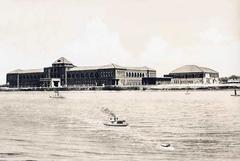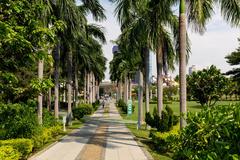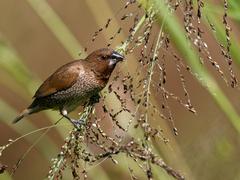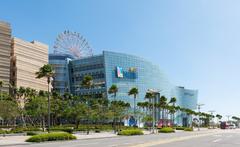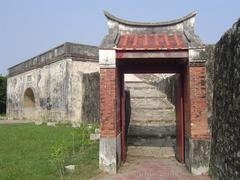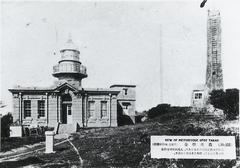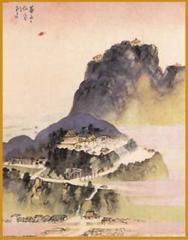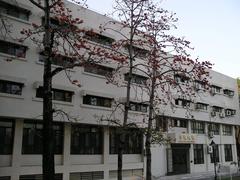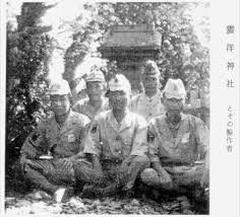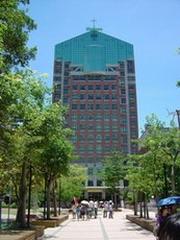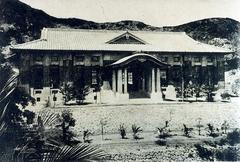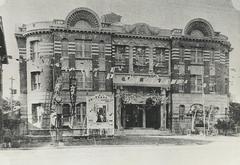
Comprehensive Guide to Visiting Kaohsiung, Taiwan
Date: 13/08/2024
Captivating Introduction
Welcome to Kaohsiung, Taiwan’s dazzling gem on the southwestern coast, where ancient traditions dance harmoniously with modern marvels. Once known as ‘Takao,’ meaning ‘bamboo forest,’ Kaohsiung has grown from its indigenous roots into a vibrant metropolis that beckons travelers from around the globe. Imagine strolling through bustling night markets where the aroma of stinky tofu mingles with the salty sea breeze, or standing in awe before the colossal bronze Buddha at the Fo Guang Shan Buddha Museum. Kaohsiung is a city of contrasts and surprises, where economic powerhouses coexist with serene temples and lush parks. From the historic Cijin Island to the futuristic Pier-2 Art Center, this city offers a sensory feast that engages all your senses. Get ready to uncover Kaohsiung’s hidden gems, quirky customs, and rich cultural heritage, all while navigating its efficient MRT system and indulging in its diverse culinary delights. Whether you’re a history buff, a foodie, or an art lover, Kaohsiung promises an unforgettable adventure (CK Travels, Discovering TW).
Table of Contents
- Historical Overview
- Cultural and Historical Landmarks
- Significance of Kaohsiung, Taiwan
- Top Attractions in Kaohsiung, Taiwan: A Journey Through This Vibrant City
- Fo Guang Shan Buddha Museum
- Lotus Pond
- Love River
- Cijin Island
- The Pier-2 Art Center
- Kaohsiung Museum of Fine Arts
- Liuhe Night Market
- Ruifeng Night Market
- Maolin National Scenic Area
- Tianliao Moon World Geological Park
- Kaohsiung City History Museum
- Formosa Boulevard Station
- Spring and Autumn Pavilions
- Kaohsiung Film Archive
- Kaohsiung Mosque
- Practical Information for Travelers
Historical Overview of Kaohsiung, Taiwan
A Journey Through Time: Early History and Development
Kaohsiung, originally inhabited by the Makatao and Siraya tribes, was once known as ‘Takao,’ meaning ‘bamboo forest.’ The city’s history began long before it became the bustling metropolis it is today.
Dutch and Spanish Influence
In the early 17th century, the Dutch East India Company left its mark on Taiwan, including Kaohsiung. The Spanish also made a brief appearance in northern Taiwan, but their impact didn’t quite reach Kaohsiung.
Qing Dynasty Era
During the Qing Dynasty (1683-1895), Kaohsiung was recognized for its strategic harbor, leading to significant development and laying the foundation for future growth.
Japanese Colonial Period
The Japanese colonial period (1895-1945) was a pivotal time for Kaohsiung. The Japanese undertook extensive modernization projects, including developing the port and industrial facilities. This era saw the renaming of ‘Takao’ to ‘Kaohsiung’ and the construction of the Takao Railway Station, now the Takao Railway Museum.
Post-World War II and Modern Era
Post-World War II, Kaohsiung flourished as an industrial and commercial hub. The establishment of the Kaohsiung Export Processing Zone in 1966 marked a significant milestone in the city’s industrial development.
Cultural and Historical Landmarks
Hidden Gems and Local Secrets
Beyond the well-known landmarks, Kaohsiung’s local night markets and quirky temples offer a more intimate experience of its vibrant culture.
Religious and Spiritual Sites
Kaohsiung’s spiritual side is equally captivating. The Fo Guang Shan Buddha Museum is one of the largest Buddhist complexes in Taiwan. The Dragon and Tiger Pagodas at Lotus Pond are iconic structures that symbolize the city’s cultural and religious heritage.
Modern Developments and Urbanization
Recent years have seen significant urbanization in Kaohsiung. The Pier-2 Art Center, a former warehouse district, is now a vibrant cultural hub. The Formosa Boulevard Station, with its stunning Dome of Light, is considered one of the most beautiful metro stations in the world.
Economic Significance
Kaohsiung’s port remains one of the busiest globally, crucial to Taiwan’s economy. The city’s industrial base has diversified with significant investments in high-tech industries and green energy. The Kaohsiung International Airport connects the city to major Asian destinations, enhancing its economic significance.
Festivals and Cultural Events
Kaohsiung hosts vibrant festivals celebrating its cultural heritage. The Kaohsiung Lantern Festival lights up the Love River, while the Zuoying Wannian Folklore Festival at Lotus Pond showcases traditional Taiwanese performances and rituals.
Visitor Tips
Utilize the Kaohsiung MRT system to navigate efficiently. Consider purchasing a 4G sim card for seamless connectivity.
Call to Action
Discover Kaohsiung with Audiala and enhance your exploration experience. Dive deep into the city’s rich heritage and dynamic future with our app guiding you every step of the way.
Conclusion
Kaohsiung’s transformation from an indigenous settlement to a modern metropolis is a testament to its resilience and strategic importance. The city’s blend of historical landmarks, cultural sites, and modern developments offers a unique and enriching experience for visitors. By exploring Kaohsiung, tourists can gain a deeper appreciation of Taiwan’s rich heritage and dynamic future.
Significance of Kaohsiung, Taiwan
Economic Hub and Port City
As Taiwan’s largest port city, Kaohsiung hums with the energy of international trade. The Port of Kaohsiung, Taiwan’s busiest harbor, handles over 67% of the nation’s container throughput. This makes it a linchpin in the global supply chain and a pivotal player in Taiwan’s economic landscape.
Industrial Powerhouse
Kaohsiung isn’t just about ships and containers; it’s also a titan in industries like manufacturing, steel-making, oil refining, freight transport, and shipbuilding. These industries have transformed the city into an industrial powerhouse, contributing to its rapid urbanization and economic growth.
Cultural and Historical Significance
Kaohsiung’s rich tapestry of history is woven with well-preserved sites like the Takau Old Fort and the Fongyi Academy. The Takau Old Fort, built in the 17th century, offers glimpses into the city’s maritime heritage and early settler challenges. The Fongyi Academy, established during the Qing Dynasty, played a crucial role in promoting education.
Political Landscape
Kaohsiung has been at the heart of Taiwan’s political shifts. The 1979 Kaohsiung Incident, where the government suppressed a commemoration of International Human Rights Day, marked a critical turning point in Taiwan’s political history. Today, Kaohsiung stands as a political center for the Pan-Green population, offering a counterbalance to Taipei’s Kuomintang support.
Tourism and Attractions
Kaohsiung is a treasure trove of attractions. From the bustling night markets of Kaisyuan and Jin-Zuan, where the aroma of local cuisine fills the air, to the Lotus Pond with its temples, pavilions, and pagodas, the city offers a sensory feast. The Pier-2 Art Center, a former warehouse complex, now serves as a cultural hub with exhibitions, coffee shops, and theaters. Don’t miss the Formosa Boulevard Station and its stunning Dome of Light.
Natural Beauty and Day Trips
Beyond its urban attractions, Kaohsiung offers natural wonders like Tianliao’s surreal eroded hillsides and the rugged, treeless mountains of Moon World. For those seeking cultural immersion, Meinong with its colorful flower beds and authentic Hakka cuisine is a must-visit.
Connectivity and Infrastructure
Kaohsiung boasts excellent connectivity, with high-speed and conventional rail links, several national freeways, and the Kaohsiung International Airport, Taiwan’s second busiest airport. This robust infrastructure ensures the city is easily accessible for both domestic and international travelers.
Culinary Delights
Kaohsiung’s culinary scene is a smorgasbord of flavors. From fresh seafood and lamb hotpot to Hakka cuisine, the city’s food offerings reflect its rich cultural heritage. Local specialties like sticky rice with pork wrapped in leaves, taro and pork dumplings, and aboriginal sausage are must-tries for food enthusiasts.
Educational and Intellectual Heritage
The Fongyi Academy, a significant historical site established during the Qing Dynasty, highlights Kaohsiung’s intellectual heritage. The academy’s elegant courtyards and traditional architecture provide a tranquil setting for exploring the city’s academic past.
Resilience and Adaptation
Kaohsiung’s history is a testament to the resilience and adaptability of its people. From its beginnings as a small fishing village to its transformation into a bustling economic center, the city has continually evolved to meet changing times. This resilience is evident in its recovery from events like the damage to its port during World War II and the political upheavals of the late 20th century.
In summary, Kaohsiung’s significance lies in its multifaceted role as an economic powerhouse, cultural and historical treasure trove, political center, and tourist destination. Its strategic location, robust infrastructure, and rich cultural heritage make it a city of immense importance in Taiwan and beyond.
Top Attractions in Kaohsiung, Taiwan: A Journey Through This Vibrant City
Fo Guang Shan Buddha Museum
Imagine standing in awe before a colossal bronze Buddha. The Fo Guang Shan Buddha Museum is a sanctuary of peace and spirituality. Wander through halls dedicated to Buddhist teachings, and don’t miss the serene Eight Pagodas. Pro tip: Catch the sunset here for a moment of zen (Agoda).
Lotus Pond
A stroll around Lotus Pond is like walking through a living postcard. Marvel at the vibrant Dragon and Tiger Pagodas, where legend has it that good luck awaits those who enter through the dragon’s mouth and exit through the tiger’s. Insider tip: Visit early in the morning for a peaceful experience, with the temples’ reflections dancing on the water (Agoda).
Love River
Take a romantic boat ride down Love River, a beloved landmark known for its picturesque walkways and vibrant cafes. As you drift along, you’ll hear the soft hum of street musicians and the laughter of locals. In the evening, the river transforms into a glittering pathway of lights. Challenge: Find the best spot to capture the city’s nightscape (Facts.net).
Cijin Island
Escape to Cijin Island, just a short ferry ride from the mainland. This local favorite boasts sandy beaches, a historic lighthouse, and the freshest seafood you’ll ever taste. Explore the quirky Windmill Park or the ancient Cihou Fort. Don’t leave without trying the island’s famous grilled squid (Facts.net).
The Pier-2 Art Center
Once a forgotten warehouse district, Pier-2 Art Center is now a vibrant hub of creativity. Discover contemporary art, eclectic exhibitions, and interactive installations. Keep your camera ready—this place is an Instagrammer’s dream. Mini-quest: Find the most unusual piece of art and share it with your followers (Agoda).
Kaohsiung Museum of Fine Arts
Nestled in the lush Gushan District, the Kaohsiung Museum of Fine Arts invites you to explore a diverse collection of art. From contemporary pieces to traditional Chinese paintings, it’s a cultural journey. The outdoor sculptures and tranquil lake make it an ideal spot for reflection. Fun fact: The museum’s park is a favorite among local joggers (Agoda).
Liuhe Night Market
Dive into the vibrant chaos of Liuhe Night Market. Here, the air is thick with enticing aromas—stinky tofu, grilled squid, and sweet papaya milk. It’s a sensory overload in the best way possible. Tip: Go hungry and try a little bit of everything. For a fun challenge, see if you can spot the most unusual snack (Agoda).
Ruifeng Night Market
Ruifeng Night Market is another culinary haven, famed for its seafood and innovative street food. Indulge in local favorites and discover new tastes. Interactive idea: Create a food bingo card with local delicacies and see how many you can check off (Agoda).
Maolin National Scenic Area
Nature lovers, this one’s for you. The Maolin National Scenic Area is a lush paradise, home to the mesmerizing Purple Butterfly Valley. Visit during mating season to witness thousands of butterflies. Explore indigenous Rukai villages, soak in hot springs, and hike trails that offer stunning vistas. Local legend: The butterflies are believed to bring luck to those who see them (Facts.net).
Tianliao Moon World Geological Park
Step into another world at Tianliao Moon World Geological Park. The lunar-like landscape with its peculiar rock formations is a photographer’s dream. Walk the trails and feel like you’re on an interplanetary adventure. Fun fact: The park gets its name because the terrain resembles the surface of the moon (Facts.net).
Kaohsiung City History Museum
Journey through time at the Kaohsiung City History Museum. Housed in a historic building, the museum offers interactive exhibits that tell the story of Kaohsiung’s transformation from a fishing village to a bustling metropolis. Anecdote: The building itself has survived several earthquakes, adding to its historical significance (Facts.net).
Formosa Boulevard Station
Formosa Boulevard Station isn’t just a metro stop; it’s a visual masterpiece. The “Dome of Light” is the largest stained-glass installation in the world. The vibrant colors and intricate designs are perfect for a photo op. Tip: Try visiting during different times of the day to see how the light changes the artwork (Agoda).
Spring and Autumn Pavilions
Located at Lotus Pond, the Spring and Autumn Pavilions are dedicated to Guan Yu, the Chinese god of war. The pavilions are connected by a bridge and feature a massive statue of Guanyin, the goddess of mercy. Hidden gem: Look for the small garden behind the pavilions for a quiet spot to reflect (Facts.net).
Kaohsiung Film Archive
Celebrate the magic of Taiwanese cinema at the Kaohsiung Film Archive. Watch classic films, attend festivals, and explore exhibitions dedicated to the rich history of Taiwanese film. Personal tip: Check out the rooftop for a stunning view of the city skyline (Facts.net).
Kaohsiung Mosque
Visit the Kaohsiung Mosque, a symbol of religious harmony and an architectural gem. Its serene ambiance makes it a peaceful retreat from the bustling city. Cultural note: Visitors are welcome to observe prayers, but remember to dress modestly as a sign of respect (Facts.net).
Practical Information for Travelers
Navigating Kaohsiung is a breeze with its efficient MRT system. Renting a bike is perfect for exploring Cijin Island. The city’s tropical climate means lightweight clothing and sunscreen are your best friends. While Mandarin is commonly spoken, learning a few basic Taiwanese Hokkien phrases can win you smiles. The New Taiwan Dollar (TWD) is the currency, and ATMs are plentiful. Sustainable tourism is a priority here, so reduce plastic use and support eco-friendly businesses (Agoda).
Explore Kaohsiung with Audialaand uncover even more hidden gems! Download the app for an enhanced adventure.
Call to Action
Kaohsiung’s journey from a humble fishing village to a bustling economic and cultural hub is nothing short of extraordinary. This city is a testament to resilience, adaptability, and the harmonious blend of tradition and innovation. As you explore Kaohsiung, you’ll be captivated by its historical landmarks like the Former British Consulate at Takao and the Cihou Fort, its vibrant cultural sites such as the Dragon and Tiger Pagodas, and its modern developments like the Pier-2 Art Center. The city’s economic significance is evident in its bustling port and thriving industries, while its rich cultural heritage shines through in its festivals, culinary delights, and spiritual sites. Whether you’re wandering through the serene Lotus Pond or diving into the chaos of Liuhe Night Market, Kaohsiung offers a unique and enriching experience that will leave you with lasting memories. With the Audiala app as your guide, you’ll uncover even more hidden gems and expert insights, making your journey through Kaohsiung truly unforgettable. Download Audiala now and let the city’s secrets and stories unfold before you (The Amazing Taiwan, Facts.net).
References
- CK Travels, 2024, CK Travels source url
- Discovering TW, 2024, Discovering TW source url
- The Amazing Taiwan, 2024, The Amazing Taiwan source url
- Facts.net, 2024, Facts.net source url






